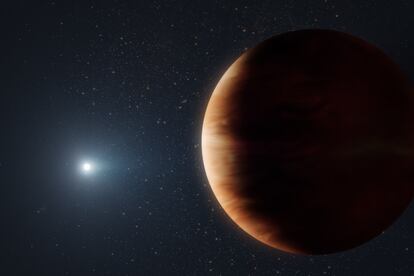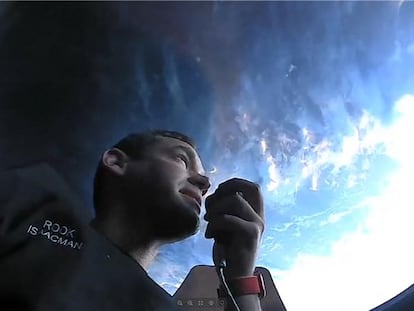A newly discovered planetary system offers peek at the future after the Sun’s death
International research group finds evidence that some outlying planets could survive an event expected to take place around five billion years from now

An international group of scientists, with the participation of the Astrophysics Institute of Andalusia-Spanish National Research Council (IAA-CSIC), has discovered a planetary system formed by a giant planet similar to Jupiter that is orbiting a white dwarf.
This gas giant is 40% more massive than Jupiter while the white dwarf is 60% larger than the Sun. The results of the investigation have been published in Nature. Camilla Danielski, an IAA-CISC astrophysicist and one of the authors of the study, says that with this discovery “there are guarantees that there are planets in our system that can survive the evolution of the star.” This could provide clues as to the future of the Solar System when the Sun reaches the end of its existence and becomes a red giant in five billion years.
The Sun, just like other similar stars, evolved over the course of millions of years until it turned into a white dwarf, like the star that formed the recently discovered planetary system. Pedro Amado, lead researcher in charge of the CSIC’s Cármenes telescope, whose mission is to seek out exoplanets, explains the process: “These solar-type stars [which take this form when they start to burn out] go through a red giant phase in which the external layers expand at the same time as the star is consuming the materials it contains to generate energy, and there comes a point in which these outermost layers are emitted to the exterior. What remains exposed is the nucleus of the star, which is what we know as a white dwarf.”
The new planetary system was first seen in 2010 via gravitational microlensing, a technique that is sensitive to cold planets and permits the detection of objects around any kind of star. The main difference between gravitational microlensing and other methods of detection is that it does not rely on the light being emitted from the host star. Subsequently, the system was observed and photographed on several more occasions with the infra-red instrumentation on the US Keck II telescope based in Hawaii. While attempting to study the host star, the scientific team noticed that its light was insufficiently bright to be that of a host star. Due to its characteristics, the hypotheses that it could be a neutron-based star, a black hole or a brown dwarf were also ruled out. As such, it had to be a white dwarf.
The investigators say that the distance of separation between giant planets and these stars is generally five or six astronomical units (AU, the average distance between the Earth and the Sun, which is around 93 million miles or 150 million kilometers). On this occasion, however, the orbital separation has been measured at 2.8 AU. Furthermore, the researchers point out that the planet and the host star were born at the same time.
Speaking about the ramifications of the study, Amado stresses that it is one of the first and most important steps toward unraveling the complete history of the Solar System, meaning “what will come to pass in the future,” and adds that it could also help to understand the complete evolution of planetary systems. As to what will happen millions of years from now, Joshua Blackman, a professor at the University of Tasmania in Australia and the lead author of the paper, says that the evolution of the Sun will destroy Mercury and Venus and quite possibly the Earth. On the other hand, Mars and the rest of the outlying gas giants will survive. “Our discovery provides evidence that it is probable that the standard picture of how planetary systems evolve as their host star dies is correct,” Blackman says. As to the surviving planets, Danielski states that they have to be within a specific range of separation from their star, neither so close that the planet is swallowed up, nor too far away that it is simply lost in the vastness of space.
Future studies
Studies on these planetary systems have been ongoing for years, but this latest research has proven more successful. In September 2020, another paper was published in Nature in which a possible candidate for a giant planet transiting a white dwarf was put forward. This planetary object was approximately the same size as Jupiter and is “no more than 14 times as massive,” with a 95% level of confidence, according to the paper. Danielski states that the problem with this research is that the exact mass of the planet is not known. Only the upper limit is known with certainty and, as such, it may or may not be a planet.
Amado and his colleagues at IAA-CSIC maintain their intention to discover other planetary systems like this one using Espresso, a very high-resolution spectrographic instrument housed at the European Southern Observatory’s VLT (Very Large Telescope) facility in Chile. Espresso measures radial velocity in meters per second. According to the Spanish Astrophysics Society, radial velocity is “the speed with which a celestial object, normally a star, moves away from or toward the Earth.” The goal is to detect a giant planet in the vicinity of a white dwarf, but considerably closer and which can be observed “as many times as we wish,” says Amado.
Tu suscripción se está usando en otro dispositivo
¿Quieres añadir otro usuario a tu suscripción?
Si continúas leyendo en este dispositivo, no se podrá leer en el otro.
FlechaTu suscripción se está usando en otro dispositivo y solo puedes acceder a EL PAÍS desde un dispositivo a la vez.
Si quieres compartir tu cuenta, cambia tu suscripción a la modalidad Premium, así podrás añadir otro usuario. Cada uno accederá con su propia cuenta de email, lo que os permitirá personalizar vuestra experiencia en EL PAÍS.
¿Tienes una suscripción de empresa? Accede aquí para contratar más cuentas.
En el caso de no saber quién está usando tu cuenta, te recomendamos cambiar tu contraseña aquí.
Si decides continuar compartiendo tu cuenta, este mensaje se mostrará en tu dispositivo y en el de la otra persona que está usando tu cuenta de forma indefinida, afectando a tu experiencia de lectura. Puedes consultar aquí los términos y condiciones de la suscripción digital.
More information
Archived In
Últimas noticias
Most viewed
- Reinhard Genzel, Nobel laureate in physics: ‘One-minute videos will never give you the truth’
- Oona Chaplin: ‘I told James Cameron that I was living in a treehouse and starting a permaculture project with a friend’
- Pablo Escobar’s hippos: A serious environmental problem, 40 years on
- Why we lost the habit of sleeping in two segments and how that changed our sense of time
- Chevy Chase, the beloved comedian who was a monster off camera: ‘Not everyone hated him, just the people who’ve worked with him’











































